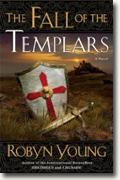The Fall of the Templars
Robyn Young
book reviews:
· general fiction
· chick lit/romance
· sci-fi/fantasy
· graphic novels
· nonfiction
· audio books
· author interviews
· children's books @
curledupkids.com
· DVD reviews @
curledupdvd.com
newsletter
win books
buy online
links
home
for authors
& publishers
for reviewers

 |
The Fall of the Templars Robyn Young Dutton Hardcover 496 pages January 2009 |
|
Click here to read reviewer Steven Rosen's take on The Fall of the Templars. The Crusades seem to have found purchase on the popular imagination in recent years—the many offerings in this burgeoning genre attest to this fact—but quality varies, for historical fiction presents a treacherous ground for any writer wishing to set up camp in that territory. The greatest problem facing the writer of historical fiction results from the clash between the necessities of historical fact and the demands of entertainment. Robyn Young seems to be one of the few
who can balance history and the demands of the thriller successfully. Her previous novel,
Crusade, is a gripping read from the very first chapter. The Fall of the Templars
In this climate, without leadership able to rise to the challenges, pursuing instead yet another crusade that cannot but fail, and corrupted by secret cabals within who perform abominable rituals of initiation, they become a pawn in the power plays between the French and the English kings, a target of greed, and are eventually torn asunder. In the midst of the turmoil stands Will Campbell. Haunted by the events of recent history, the failure of the Templars in the Holy Land specifically, and crippled by personal rage against the English King on whom he wishes to avenge the betrayal of Anima Templi, Campbell accompanies Grand Master de Molay and other senior leadership of the Templars on a mission to England to try to avert the possible merger of the Templars and their bitter rivals, the Hospitaliers, at any cost. Compromise follows, then its handmaiden, betrayal, as the Templars decide to side with Edward against Scotland. Stunned by the turn of events, Campbell tries to reason with his brothers, revealing to them the secret truths of which only he seems to be aware about Edward's treachery. Sadly, no one is willing to see the English monarch as enemy, deluded as they are in their despair for a patron and savior by false hopes of receiving from the treacherous king future guarantees and alliances. Campbell's anger makes him act rashly, and he deserts the Temple, gives up on his leadership of Anima Templi and its dream of peace between the three great faiths. He wanders in Scotland, eventually joining in the rebellion of William Wallace in a plodding Scottish interlude that is only semi-interesting. Campbell's story essentially meanders through historical events such as the rebellion of William Wallace, sometimes drowning beneath the surface other story lines and events as he writhes purposelessly for many pages, coming and going from Paris to London to Scotland's battlefields then back again, while the business of the Templars is a mere echo reverberating through secondary story lines. Reading, you start wonder: how is any of this about the fall of the Templars? It is only after two hundred pages that a semblance of a plot line begins to take shape as Campbell finally learns of the French king's plot to use the Papacy to destroy the Templar knights. All this is a disappointment because Young can write better; in
Crusade, she sets a time bomb ticking in the very first chapter, and the book is a thrill to read. I wish she
had done the same in The Fall of the Templars Originally published on Curled Up With A Good Book at www.curledup.com. © A. Jurek, 2009 |
| Also by Robyn Young: |
|
|
|
 Click here to learn more about this month's sponsor! |
|
| fiction · sf/f · comic books · nonfiction · audio newsletter · free book contest · buy books online review index · links · · authors & publishers reviewers |
|
| site by ELBO Computing Resources, Inc. | |
 Robyn Young had explored Crusade territory before in
Brethren (2006) and Crusade (2007). Both books follow the life and the adventures of a Templar knight named Will Campbell of Scotland, member of a secret order within the Templars known as
Anima Templi. In the third installment in the series,
Robyn Young had explored Crusade territory before in
Brethren (2006) and Crusade (2007). Both books follow the life and the adventures of a Templar knight named Will Campbell of Scotland, member of a secret order within the Templars known as
Anima Templi. In the third installment in the series,